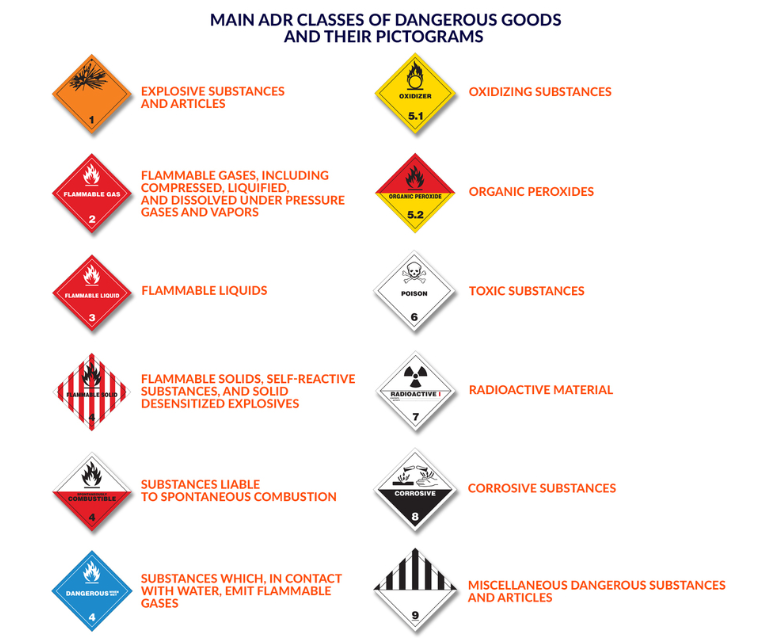Be your Logistics Department in China
Customized logistics solutions, your logistics expert in China
Customized logistics solutions, Shipping from China to the World
Tel:+8613424475220 Email:info@viputrans.com 
It turns out that not all products can be imported from China. This is due to the different criteria for the transport of dangerous goods. Due to differences between the laws in force in different parts of the world, some goods are not allowed for international transport.
The commonly used ADR name is an abbreviation of the French name for the international convention L ‘Accord européen relatif au transport international des marchandises Dangereuses par Route.
The ADR agreement is based on the same fundamentals as other contracts for the transport of dangerous goods: by sea (IMDG), by air (ICAO) and by rail (RID).
We must remember that the rules for the transport of dangerous goods are not only determined by ADR convention but also by acts of the local law of individual countries.
According to international regulations, the transport of hazardous materials can take place by any technically prepared mode of transportation. Depending on the type of transported goods, there are guidelines on which mode of transport is the most appropriate. For example, products such as explosives, flammable liquids, or radioactive materials are not allowed at all for sea transport.
That is why in Europe is a legal division into a mode of transport by road ADR, rail RID, sea IMDG, air ICAO/IATA, and inland ADN. It is worth noting that changes to the regulations are updated every two years, except for air transport (IATA), which is updated every year.

ADR transport agreement
In addition to the applicable contract, specifying the main resolutions, the contract also contains annexes A and B.
Annex A contains a detailed classification of all materials considered dangerous in the world (classified by the UN in the TN catalog), i.e., being harmful to people, the environment, and material goods. It also determines the conditions of their transport. Each of these materials is given a four-digit number (the so-called “UN number”), and the agreement divides them into 13 hazard classes:
Class 1 Explosive substances and articles
Class 2 Gases, including compressed, liquified, and dissolved under pressure gases and vapors
Flammable gases (e.g., butane, propane, acetylene)
Non-flammable and non-toxic, likely to cause asphyxiation (e.g., nitrogen, CO2) or oxidizers (e.g., oxygen)
Toxic (e.g., Chlorine, Phosgene)vit
Class 3 Flammable liquids
Class 4.1 Flammable solids, self-reactive substances, and solid desensitized explosives
Class 4.2 Substances liable to spontaneous combustion
Class 4.3 Substances which, in contact with water, emit flammable gases
Class 5.1 Oxidizing substances
Class 5.2 Organic peroxides
Class 6.1 Toxic substances
Class 6.2 Infectious substances
Class 7 Radioactive material
Class 8 Corrosive substances
Class 9 Miscellaneous dangerous substances and articles
Annex B defines requirements for the vehicle crew and other persons involved in the transport, construction, and equipment of vehicles transporting hazardous materials (including trailers, cisterns, containers, etc.). It also contains information on the documentation required for transport and the rules for transporting this type of material through tunnels.
The vehicle transporting hazardous materials must be appropriately marked. Special warning stickers and boards in orange are used for this. In some cases, when the quantity of the product does not exceed the determined value, this rule does not apply.
The necessary equipment in which the driver must be equipped is the so-called “ADR box.” In any case, it must contain a wedge under the wheels and two standing warning signs, and in most cases, eyewash.
And ADR agreement also defines what the driver must fulfill requirements to transport hazardous materials. Drivers are required to have an ADR certificate, which can be purchased in progress of the appropriate course. Besides, the driver must be at least 21 years old.
As you can see, the requirements and regulations included in ADR are quite complicated and depend on many factors.

The ADR agreement is amended every two years in an odd year, so on January 1, 2019, its latest version entered into force. This version is obligatory from July 1, 2019.
Of all types of road transport, the transport of hazardous materials is undoubtedly one of the most complicated ones. Thanks to agreements such as ADR, we can be sure that these materials will be transported properly, without endangering the health and life of unauthorized persons and the environment.
If you are interested in transporting dangerous goods, you can contact our company at any time. I will provide you with a PPT introduction of our company's transportation of dangerous goods.
Shawn.Liao(Mr.)
E-MAIL:sales04@viputrans.com
Wechat: +8618926970495// viputrans04
Whatsapp/Skype: +8613431563558
WCA Member ID No.129936
Copyright © 2003-2025 VIPU Supply Chain Logistics Co., Ltd. | All Rights Reserved
LOGISTICS | E-COMMERCIAL FULFILLMENT | ABOUT US | CASE | NEWS | VIDEO | CONTACT US
We will find the fastest or the cheapest way for your shipment. Please specify: where from, where to, what to ship.